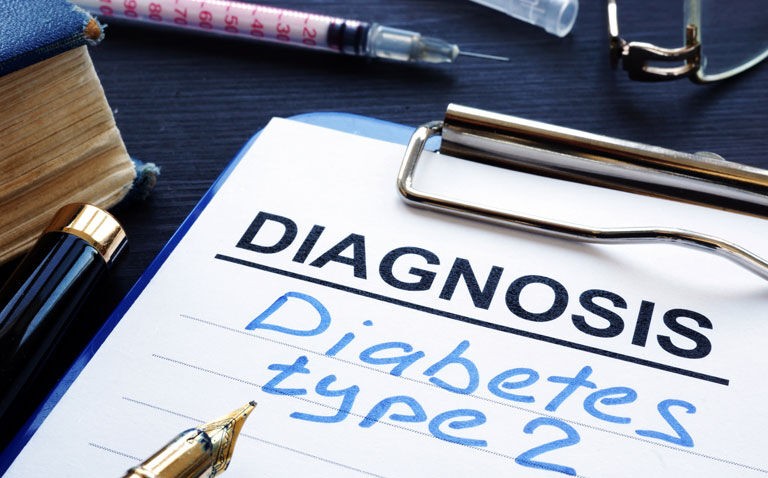A new study has revealed for the first time the range and type of illnesses that people with type 2 diabetes (T2DM) are living with, highlighting that there is an urgent need for a more personalised and holistic approach to care for those suffering with the disease.
Hypertension and heart disease, conditions well known to have links with diabetes, were the first and fifth most common comorbidities. For the first time, new research has now linked back pain, depression and osteoarthritis as those included in the five most common conditions at diagnosis.
Ten years after diagnosis, retinopathy replaced heart disease in the five most common conditions in those with T2DM. A comorbidity is defined as a separate illness or condition that a person might have alongside their primary illness, T2DM, in this study.
The new real-world evidence study, published in eClinical Medicine, is co-authored by the National Institute for Health and Care Excellence (NICE), Analytics firm LCP, and Imperial College London and is the first to identify the variation in comorbidity patterns and unmet clinical need for people living with T2DM.
The new study examined approximately 224,000 people with T2DM in the Discover-NOW dataset, a real-world primary care database from 2000 to 2020 covering 2.5 million people across North-West London linked to hospital records.
The study found that while multimorbidity (two or more chronic conditions) is common in people with T2DM and increasing, the comorbidity profiles vary substantially. Nearly 30% of patients had three or more comorbidities at diagnosis, increasing to 60% of patients ten years later.
Depression is the most common emerging, non-traditional, condition and back pain was the third commonest condition overall – neither of these conditions are routinely considered in clinical or prevention guidelines for these patients.
Other key findings include:
- All of the nine most common comorbidities (defined as having a prevalence over 3% – hypertension, back pain, retinopathy, depression, osteoarthritis, ischaemic heart disease and acute myocardial infarction, asthma and renal disease) increased from 2000 to 2019. Hypertension was the commonest comorbidity throughout the study period, reaching a prevalence of 47.6% in people living with T2DM in 2019. While traditional diabetes complications, retinopathy (31.9%), ischemic heart disease and acute myocardial infarction (13.6%), and renal disease (11.7%) were some of the commonest comorbidities, there was a diverse range of disorders. Back pain (39.7%), depression (25.7%) and osteoarthritis (15.7%) were 2nd, 4th, and 5th most common comorbidities in people with T2DM over the last ten years of the study period.
- Comorbidities and clinical need varied by ethnicity. Hypertension was the most common comorbidity at diagnosis across all ethnic groups (ranging from 33% to 41%) but there were noticeable differences in specific comorbidities. Depression was almost twice as prevalent in white people (21%) compared to Asian (12%) while hypothyroidism was twice as prevalent in Asian people compared to black people. Severe mental illness, cancer, stroke, and chronic kidney disease were all higher in black people.
- Depression, hypothyroidism, and osteoarthritis prevalence were 2–3-times higher in women than men at 19.6% (compared with 11.6%), 10.2% (compared with 3.1%) and 14.2% (compared with 8.4%).
- People with five or more comorbidities at diagnosis had higher prevalence of each of the 35 comorbidities. Hypertension (73%) was the most common comorbidity at diagnosis in this group; followed by back pain (69%), depression (67%), asthma (45%) and osteoarthritis (36%).
- People with obesity at diagnosis had substantially different comorbidity profiles to those without, and the five commonest comorbidities were 50% more common in this group.
While the study has identified these patterns of comorbidities in people diagnosed with diabetes, more research is needed to understand how these patients can be identified and what interventions should be targeted at those patients to improve their outcomes.
Lead author of the study, Dr Jonathan Pearson-Stuttard, Head of Health Analytics at LCP, said: ‘While we expected hypertension and heart disease, known complications of diabetes, to be common in people living with type 2 diabetes, our findings that back pain, depression and osteoarthritis are so common was unexpected.
‘This highlights the breadth of ill-heath faced by people living with type 2 diabetes yet these conditions are not part of routine clinical and prevention guidelines. As multimorbidity increases and the clinical needs of patients evolve and become more unequal, guidelines and care pathways must adapt to be both more holistic and target those with greatest need. This would improve the population’s health, inequalities and in turn economic prosperity.’
Report co-author, Dr Pall Jonsson, Programme Director for Data and RWE at NICE, added: ‘Around one in ten people over 40 in the UK are now living with a diagnosis of type 2 diabetes and that number is projected to rise to over 5 million by 2030.
‘Until now there has been limited research on the impact of multi- and comorbidities across different patient groups and how these progress during the course of the disease. This study has highlighted the large variations in clinical need within the patient group.
‘The work is also showing us how the rich clinical data that reflects patients in practice – the real-world data – can stimulate new research questions and can help inform future developments of clinical guidelines.’










